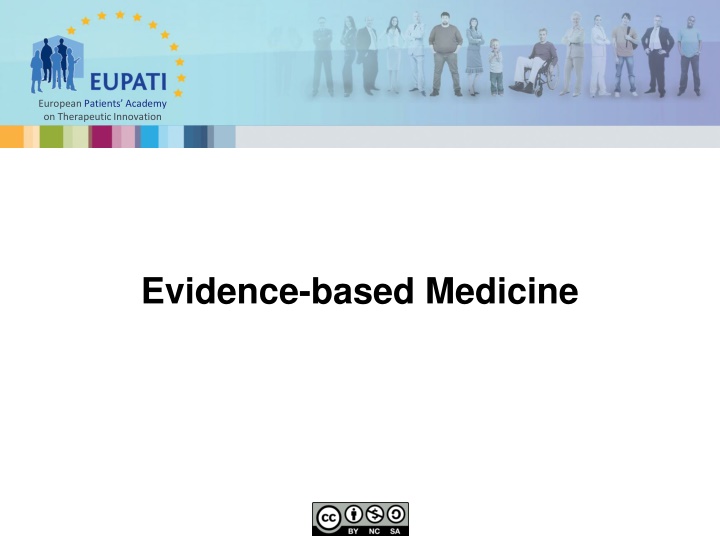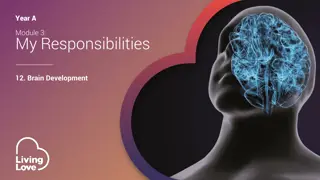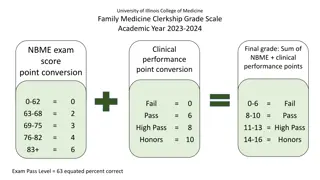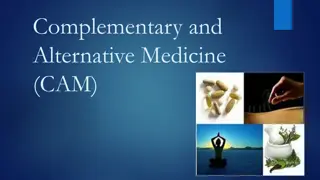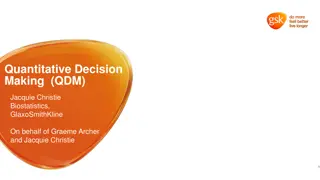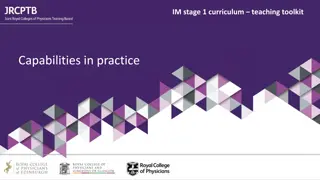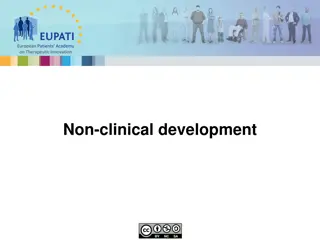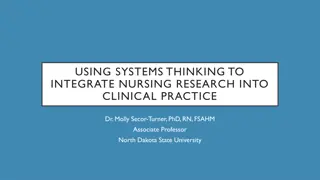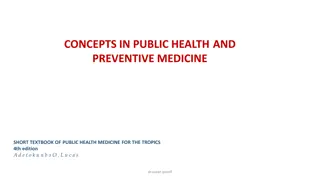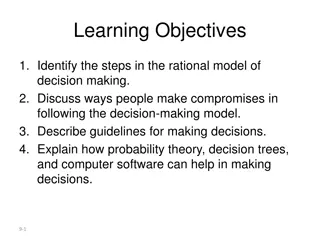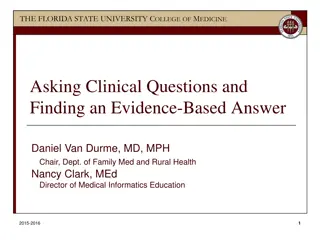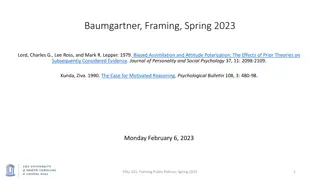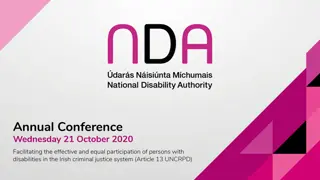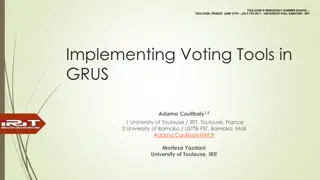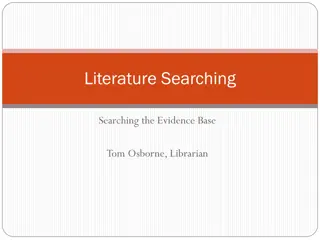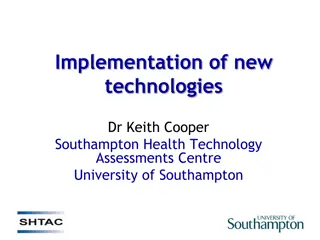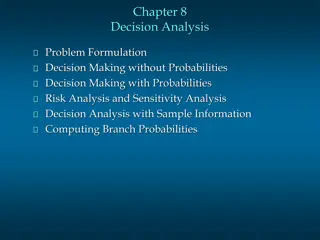Evidence-Based Medicine and Clinical Decision-Making
European Patients Academy on Therapeutic Innovation emphasizes the importance of Evidence-Based Medicine (EBM) in providing optimum clinical care. EBM involves systematic review and utilization of clinical research for informed decision-making, benefiting patients in disease management and treatment. The integration of clinical experience with evidence from controlled studies ensures effective clinical decision-making. A 5-step model guides healthcare professionals in defining questions, searching for evidence, assessing quality, acting on evidence, and evaluating outcomes to enhance patient care.
Download Presentation

Please find below an Image/Link to download the presentation.
The content on the website is provided AS IS for your information and personal use only. It may not be sold, licensed, or shared on other websites without obtaining consent from the author.If you encounter any issues during the download, it is possible that the publisher has removed the file from their server.
You are allowed to download the files provided on this website for personal or commercial use, subject to the condition that they are used lawfully. All files are the property of their respective owners.
The content on the website is provided AS IS for your information and personal use only. It may not be sold, licensed, or shared on other websites without obtaining consent from the author.
E N D
Presentation Transcript
European Patients Academy on Therapeutic Innovation Evidence-based Medicine
Evidence-based Medicine European Patients Academy on Therapeutic Innovation Evidence-based medicine (EBM) is about systematically reviewing, appraising, and using clinical research findings to aid the delivery of optimum clinical care to patients. Patient knowledge of EBM is important because it enables them to make more informed decisions about disease management and treatment. It also gives patients a more accurate perception of risk, encourages appropriate use of elective procedures, and supports evidence-based doctor/patient decision- making. 2
Evidence-based Medicine European Patients Academy on Therapeutic Innovation Evidence-based medicine is a combination of principles and methods. When put into action, these ensure that medical decisions, guidelines, and policies are based on the current best evidence about the effects of different forms of treatment and healthcare in general. With respect to medicines, it draws heavily on information from the benefit and risk (efficacy and safety) evaluation. 3
Clinical Experience European Patients Academy on Therapeutic Innovation The decision-maker needs to look at knowledge from their own clinical experience along with the best evidence from controlled studies and research. Combining clinical experience and controlled studies in the decision-making process is important. Without clinical experience, the risk related to a given treatment may end up causing unwanted effects. 4
5-Step Model of Evidence-Based Medicine European Patients Academy on Therapeutic Innovation One approach to evidence-based medicine is based on a 5 step model: Step 1 - defining a clinically relevant question - doctor searches for information to find correct diagnosis; Step 2 - searching for the best evidence - doctor searches for evidence to support the findings from step 1; Step 3 - assessing the quality of the evidence - doctor ensures that quality and reliability is high; 5
5-Step Model of Evidence-Based Medicine European Patients Academy on Therapeutic Innovation Step 4 - acting on the evidence to form a clinical decision - based on Steps 1-3, patient and doctor jointly make an informed treatment decision; Step 5 - evaluating the process - doctor and patient assess if the intended outcome is achieved and adjust treatment decisions accordingly if needed. 6
Patient Engagement European Patients Academy on Therapeutic Innovation A doctor s decision includes conscientious, explicit, and judicious use of the best evidence at the current time, including the patient s experience, when deciding how to provide the best possible medical treatment for a given patient. Patient engagement in decision-making processes have an important role to play in building new guidelines of treatment principles. 7
Patient Engagement European Patients Academy on Therapeutic Innovation This includes reading, understanding, and acting on health information, working together with clinicians to evaluate and select the right treatment options and providing feedback on outcomes. Patients can have an active role to play at all levels of evidence. 8
Levels of Evidence European Patients Academy on Therapeutic Innovation 9
Levels of Evidence European Patients Academy on Therapeutic Innovation Editorials and Expert Opinions This is evidence based on the opinions of a panel of experts aiming to shape common medical practice. Case-Series and Case-Reports Case series are descriptive studies following one small group of people. They are additions or supplements of case reports. A case report is a detailed report of the symptoms, signs, diagnosis, treatment, and follow-up of an individual patient. 10
Levels of Evidence European Patients Academy on Therapeutic Innovation Case-Control Studies A case-control study is an observational retrospective study (looking at historical data) that compares patients who have a disease with patients who do not have the disease. Outcomes such as lung cancer are generally studied by the use of case-control studies. A group of smokers (the exposed group) and a group of non-smokers (the unexposed group) are recruited and followed over time. 11
Levels of Evidence European Patients Academy on Therapeutic Innovation Case-Control Studies The differences in the incidence of lung cancer between the groups are then documented, allowing the variable being assessed -the independent variable in this case, smoking, to be isolated as the cause of the dependent variable - lung cancer. In this example, a statistically significant increase in the incidence of lung cancer in the smoking group as compared to the non-smoking group would be considered as evidence in favour of assuming a causal relationship between smoking and lung cancer. 12
Levels of Evidence European Patients Academy on Therapeutic Innovation Cohort Studies The modern definition of a cohort in clinical studies is a group of people with defined characteristics who are followed in order to determine health-related outcomes. The Framingham Heart study is an example of the use of a cohort study to answer an epidemiological question. Another example of a cohort study that has been ongoing for many years is the National Child Development Study (NCDS), the most widely- researched of the British birth cohort studies. 13
Levels of Evidence European Patients Academy on Therapeutic Innovation Randomised Clinical Trial (RCT) A randomised clinical trial is one that uses randomisation when allocating people to different arms of the study. This means that the treatment groups are chosen by chance using a formal system and each participant has an equal chance of being selected to each arm. 14
Levels of Evidence European Patients Academy on Therapeutic Innovation Meta-analysis Meta-analysis is a systematic, statistics-based review of data that contrasts and combines results from different but related studies, in an attempt to identify patterns, disagreements, and other relationships across multiple studies. A meta-analysis can support a stronger conclusion than any individual study, but may be flawed because of publication bias. 15
Outcome Research European Patients Academy on Therapeutic Innovation Outcome research studies the end results of medical care the effect of the healthcare process on the health and well-being of patients. Clinical outcome research seeks to monitor, understand, and improve the impact of medical treatment on a specific patient or population. It describes research that is concerned with the effectiveness of public-health interventions and health services - the outcomes of these services. 16
Outcomes Research European Patients Academy on Therapeutic Innovation Attention is frequently focused on the clinical endpoints most relevant to the patient or population. Such endpoints could be quality of life or pain level. Outcomes research may also focus on the effectiveness of healthcare delivery, with measures such as cost- effectiveness, health status, and disease burden (the impact of the health problem). The difference between EBM and outcomes research is one of focus. While the main focus of EBM is providing the best care to the patient according to clinical evidence and experience, the main focus of outcomes research is predefined endpoints. 17
Outcomes Research - Endpoints European Patients Academy on Therapeutic Innovation In outcomes research, the relevant endpoints are often symptoms or functional and care measures, things considered important by the patient receiving the treatment. When study duration is long, outcomes research studies can include the use of surrogate endpoints . A surrogate endpoint is when a biomarker is used to measure an outcomes, it acts as a substitute for a clinical efficacy endpoint. When a surrogate endpoint is used for regulatory purposes, the marker should have previously been confirmed or validated. 18
Examples of Endpoints Relevant to Outcomes Research Studies European Patients Academy on Therapeutic Innovation Type of endpoint Example Physiological measure (biomarker) Blood pressure Clinical Heart pressure Symptoms Coughing Functional and care Measurement of function, for instance ability to perform tasks of everyday living, Quality of Life assessments 19
References European Patients Academy on Therapeutic Innovation World Health Organisation (2008). Where are the patients in decision-making about their own care? Retrieved 31 August, 2015, from http://www.who.int/management/general/decisionmaking/ WhereArePatientsinDecisionMaking.pdf 20
